西安邮电大学毕业设计外文翻译封面(模板)
- 格式:doc
- 大小:16.50 KB
- 文档页数:3

毕业论文(设计)
英文翻译
姓名
学号
所在学院
专业班级 2007级信科2班
指导教师
日期 2011年3月30 日
英文原文(三号宋体加粗,段前0.5行,段后0.5行,居中)
Introduce a kind of dormancy of using- restore to the throne in theoperation way and improve the anti-interference ability method of the one-chip computer;Analyse its scope of application, provide and use the circuit concretly; Combine the instance, analyse the characteristic of the hardware and software design under these kind of operation way. (Times new Roman小四,1.25倍行,段前0行,段后0行,两端对齐)
中文翻译(三号宋体加粗,段前0.5行,段后0.5行,居中)
介绍一种用休眠-复位运行方式提高单片机抗干扰能力的方法;分析其适用范围,给出具体应用电路;结合实例,分析这种运行方式下硬件和软件设计的特点。
(小四,1.25倍行,段前0行,段后0行,两端对齐)。
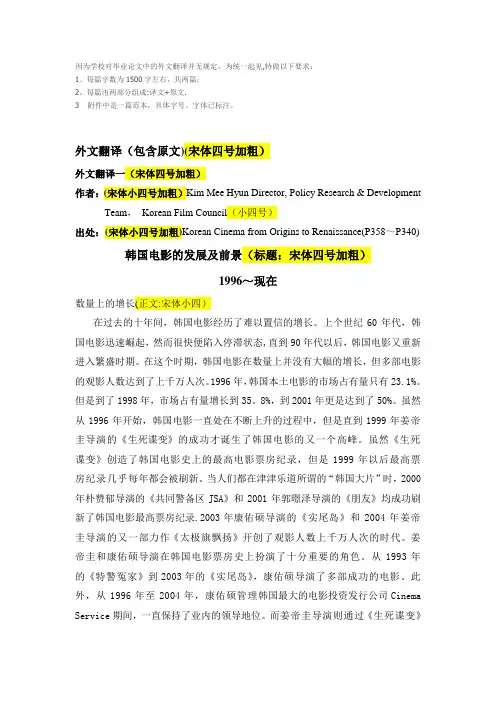
因为学校对毕业论文中的外文翻译并无规定,为统一起见,特做以下要求:1、每篇字数为1500字左右,共两篇;2、每篇由两部分组成:译文+原文.3 附件中是一篇范本,具体字号、字体已标注。
外文翻译(包含原文)(宋体四号加粗)外文翻译一(宋体四号加粗)作者:(宋体小四号加粗)Kim Mee Hyun Director, Policy Research & Development Team,Korean Film Council(小四号)出处:(宋体小四号加粗)Korean Cinema from Origins to Renaissance(P358~P340) 韩国电影的发展及前景(标题:宋体四号加粗)1996~现在数量上的增长(正文:宋体小四)在过去的十年间,韩国电影经历了难以置信的增长。
上个世纪60年代,韩国电影迅速崛起,然而很快便陷入停滞状态,直到90年代以后,韩国电影又重新进入繁盛时期。
在这个时期,韩国电影在数量上并没有大幅的增长,但多部电影的观影人数达到了上千万人次。
1996年,韩国本土电影的市场占有量只有23.1%。
但是到了1998年,市场占有量增长到35。
8%,到2001年更是达到了50%。
虽然从1996年开始,韩国电影一直处在不断上升的过程中,但是直到1999年姜帝圭导演的《生死谍变》的成功才诞生了韩国电影的又一个高峰。
虽然《生死谍变》创造了韩国电影史上的最高电影票房纪录,但是1999年以后最高票房纪录几乎每年都会被刷新。
当人们都在津津乐道所谓的“韩国大片”时,2000年朴赞郁导演的《共同警备区JSA》和2001年郭暻泽导演的《朋友》均成功刷新了韩国电影最高票房纪录.2003年康佑硕导演的《实尾岛》和2004年姜帝圭导演的又一部力作《太极旗飘扬》开创了观影人数上千万人次的时代。
姜帝圭和康佑硕导演在韩国电影票房史上扮演了十分重要的角色。
从1993年的《特警冤家》到2003年的《实尾岛》,康佑硕导演了多部成功的电影。

毕业论文(设计)外文文献翻译
系部:
专业:
学号:
姓名:
指导教师:
江苏科技大学苏州理工学院
年月日
译文标准格式(封面):
1.标题(毕业论文(设计)外文文献翻译):一号、仿宋_GB2312、居中
2.系部(小三号、宋体);内容:(四号字、黑体、居中)
3.专业(小三号、宋体);内容(四号字、黑体、居中)
4.学号(小三号、宋体);内容(四号字、黑体、居中)
5.姓名(小三号、宋体);内容(四号字、黑体、居中)
6.指导教师(小三号、宋体);内容(四号字、黑体、居中)
7.学院(江苏科技大学苏州理工学院):小二号、仿宋_GB2312、居中
8. 时间 (三号、仿宋_GB2312、居中)
译文标准格式(内容):
(1)论文题目。
三号字,黑体,加粗,居中,上下各空一行(2)作者姓名(不翻译)。
小四号字,Times New Roman字体,居中,上下各空一行
(3)作者单位。
五号字,宋体,段前、段后各空0.5行,居中(4)摘要(含关键词)。
五号字,宋体,1.35倍行距
(5)正文。
小四号字,宋体,1.35倍行距。
(6)参考文献。
五号字,作者可不翻译(Times New Roman字体),其余5号宋体。
1.35倍行距。
(7)翻译字数:不少于5000英文单词(若文章太长,可翻译一部分)。
国外作者姓名可不翻译
(8)页面设置:装订线0.5cm,上2.5cm,下2.0cm,左2.5cm,右2.0cm。
(9)原文置于外文后一起装订。
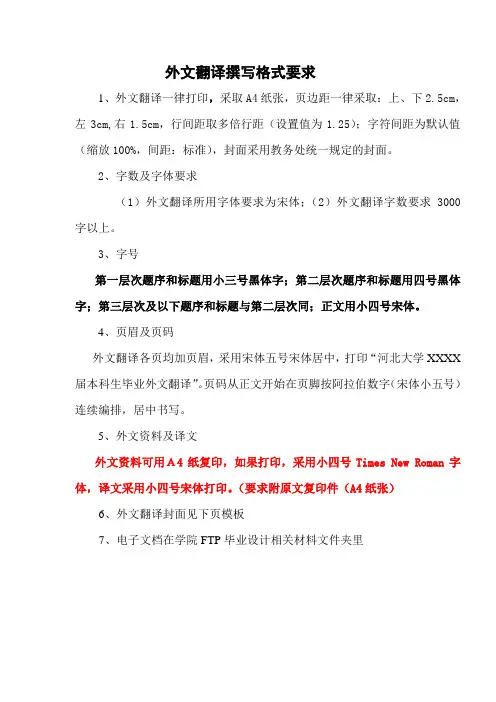
外文翻译撰写格式要求
1、外文翻译一律打印,采取A4纸张,页边距一律采取:上、下2.5cm,左3cm,右1.5cm,行间距取多倍行距(设置值为1.25);字符间距为默认值(缩放100%,间距:标准),封面采用教务处统一规定的封面。
2、字数及字体要求
(1)外文翻译所用字体要求为宋体;(2)外文翻译字数要求3000字以上。
3、字号
第一层次题序和标题用小三号黑体字;第二层次题序和标题用四号黑体字;第三层次及以下题序和标题与第二层次同;正文用小四号宋体。
4、页眉及页码
外文翻译各页均加页眉,采用宋体五号宋体居中,打印“河北大学XXXX 届本科生毕业外文翻译”。
页码从正文开始在页脚按阿拉伯数字(宋体小五号)连续编排,居中书写。
5、外文资料及译文
外文资料可用A4纸复印,如果打印,采用小四号Times New Roman字体,译文采用小四号宋体打印。
(要求附原文复印件(A4纸张)
6、外文翻译封面见下页模板
7、电子文档在学院FTP毕业设计相关材料文件夹里
本科生外文文献翻译
外文题目:Hardware-in-the-Loop Simulation System in the Development of Temperature Controller of Plastic Extruder 中文题目
: 硬件在环仿真系统在塑料挤出机温度控制器的发展中的应用
学 院 电子信息工程学院 学科门类 工学 专 业 自动化 学 号 2010448022 姓 名 李珊
装
订
线
指导教师郝雷。

毕业设计(论文)
译文及原稿译文题目:[单击此处添加译文题目]
原稿题目:[单击此处添加原稿题目]
原稿出处:[单击此处添加原稿出处]
[单击此处添加译文题目]
[单击此处添加译文正文]
以下是说明文字,正式成文后请删除。
1、模板的使用方法
(1)请不要删除任何具有格式的模板文字。
(2)按照提示直接单击或单击后选择“编辑”→“选择性粘贴”—“无格式文本”就可添加相应内容。
2、在“原稿出处”中对原稿的来源进行说明,包括作者姓名、出处、出版信息等。
期刊类文献书写方法:作者(不超过3人,多者用“等”或“et al”表示).题名[J].刊名,出版年,卷号(期号):起止页码.
论文集类文献书写方法:著者.题名[C].编者.论文集名.出版地:出版社,出版年份:起止页码.
有一篇译文,按如下顺序列出:
译文题目一
原稿题目一
原稿出处一
3、检索和利用外文资料的能力是现阶段毕业设计(论文)环节中所要求掌握的基本能力之一。
外文翻译是在查阅外文文献时,将篇幅适当、内容与选题相关的外文资料翻译成中文。
通过翻译外文资料,可更深层次地了解国外相关领域的现状,同时也是对翻译能力的锻炼,并为考察和检验学生外语能力提供依据。
4、进行外文翻译应注意以下几点:
(1)翻译的外文文献内容应与论文选题相关;一般应选自国外学术期刊、学术会议的文章及其他相关材料。
(2)篇幅、深度和难度适当,可以由1篇文章组成。
5、外文翻译字符应达到2000字符。
[单击此处添加外文原稿题目] [单击此处添加外文原稿正文]。
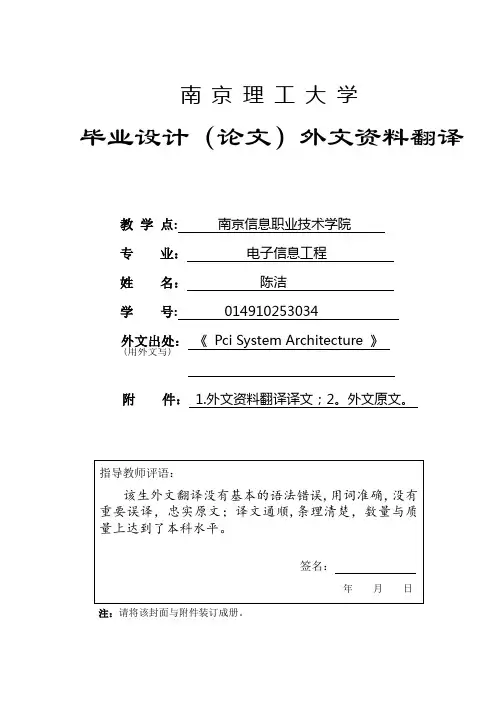
南京理工大学毕业设计(论文)外文资料翻译教学点: 南京信息职业技术学院专业:电子信息工程姓名:陈洁学号:014910253034外文出处:《Pci System Architecture 》(用外文写)附件: 1.外文资料翻译译文;2。
外文原文。
附件1:外文资料翻译译文64位PCI扩展1.64位数据传送和64位寻址:独立的能力PCI规范给出了允许64位总线主设备与64位目标实现64位数据传送的机理。
在传送的开始,如果回应目标是一个64位或32位设备,64位总线设备会自动识别.如果它是64位设备,达到8个字节(一个4字)可以在每个数据段中传送。
假定是一串0等待状态数据段。
在33MHz总线速率上可以每秒264兆字节获取(8字节/传送*33百万传送字/秒),在66MHz总线上可以528M字节/秒获取.如果回应目标是32位设备,总线主设备会自动识别并且在下部4位数据通道上(AD[31::00])引导,所以数据指向或来自目标。
规范也定义了64位存储器寻址功能。
此功能只用于寻址驻留在4GB地址边界以上的存储器目标。
32位和64位总线主设备都可以实现64位寻址。
此外,对64位寻址反映的存储器目标(驻留在4GB地址边界上)可以看作32位或64位目标来实现。
注意64位寻址和64位数据传送功能是两种特性,各自独立并且严格区分开来是非常重要的。
一个设备可以支持一种、另一种、都支持或都不支持。
2.64位扩展信号为了支持64位数据传送功能,PCI总线另有39个引脚。
●REQ64#被64位总线主设备有效表明它想执行64位数据传送操作.REQ64#与FRAME#信号具有相同的时序和间隔。
REQ64#信号必须由系统主板上的上拉电阻来支持.当32位总线主设备进行传送时,REQ64#不能又漂移。
●ACK64#被目标有效以回应被主设备有效的REQ64#(如果目标支持64位数据传送),ACK64#与DEVSEL#具有相同的时序和间隔(但是直到REQ64#被主设备有效,ACK64#才可被有效).像REQ64#一样,ACK64#信号线也必须由系统主板上的上拉电阻来支持。
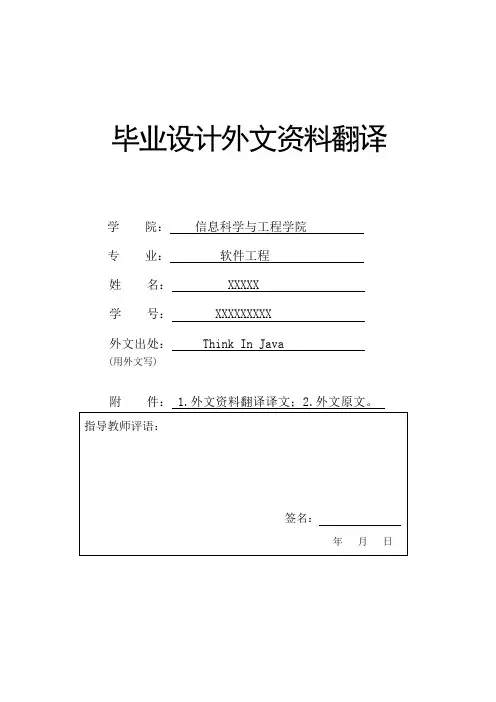
毕业设计外文资料翻译学院:信息科学与工程学院专业:软件工程姓名: XXXXX学号: XXXXXXXXX外文出处: Think In Java (用外文写)附件: 1.外文资料翻译译文;2.外文原文。
附件1:外文资料翻译译文网络编程历史上的网络编程都倾向于困难、复杂,而且极易出错。
程序员必须掌握与网络有关的大量细节,有时甚至要对硬件有深刻的认识。
一般地,我们需要理解连网协议中不同的“层”(Layer)。
而且对于每个连网库,一般都包含了数量众多的函数,分别涉及信息块的连接、打包和拆包;这些块的来回运输;以及握手等等。
这是一项令人痛苦的工作。
但是,连网本身的概念并不是很难。
我们想获得位于其他地方某台机器上的信息,并把它们移到这儿;或者相反。
这与读写文件非常相似,只是文件存在于远程机器上,而且远程机器有权决定如何处理我们请求或者发送的数据。
Java最出色的一个地方就是它的“无痛苦连网”概念。
有关连网的基层细节已被尽可能地提取出去,并隐藏在JVM以及Java的本机安装系统里进行控制。
我们使用的编程模型是一个文件的模型;事实上,网络连接(一个“套接字”)已被封装到系统对象里,所以可象对其他数据流那样采用同样的方法调用。
除此以外,在我们处理另一个连网问题——同时控制多个网络连接——的时候,Java内建的多线程机制也是十分方便的。
本章将用一系列易懂的例子解释Java的连网支持。
15.1 机器的标识当然,为了分辨来自别处的一台机器,以及为了保证自己连接的是希望的那台机器,必须有一种机制能独一无二地标识出网络内的每台机器。
早期网络只解决了如何在本地网络环境中为机器提供唯一的名字。
但Java面向的是整个因特网,这要求用一种机制对来自世界各地的机器进行标识。
为达到这个目的,我们采用了IP(互联网地址)的概念。
IP以两种形式存在着:(1) 大家最熟悉的DNS(域名服务)形式。
我自己的域名是。
所以假定我在自己的域内有一台名为Opus的计算机,它的域名就可以是。

中北大学
毕业设计外文资料翻译
原文名称Ab cd
中文名称甲乙丙丁
原文来源:作者,指期刊名称,卷期号,年月日,页码
或者其它信息
学生姓名:学号:
学院:
专业:
指导教师:
年月日
外文资料翻译要求
1.外文资料翻译中文部分内容,按照毕业设计说明书正文的格式要求排版,章节号、图号、表号、公式根据原文信息编排。
页眉填写“外文资料翻译”。
2、原始外文文献内容,直接复印原文装订在中文部分后面。
必须保留文献首页或封面,保留文献来源信息,不允许使用电子版进行二次编辑。
3、外文资料的选取提倡公开发表的与设计题目相关的科技期刊论文、图书片段、原始芯片资料、专业技术资料。
禁止选用没有来源的外文材料。
翻译后的中文部分篇幅达到10页以上即可,尽量保证翻译文献的完整性。
4、严禁机器翻译。
如果发现,直接取消答辩资格。

毕业设计中英文翻译学生姓名: 学号: 学专 指导教师:年 月(小二号居中)三号楷体 三号楷体 三号楷体1.×××××××(一级标题用小3号黑体,加粗,并留出上0.5行,段后0.5行)(作为文章2级标题,用小4号黑体,加粗)×××××××××(小4号宋体)××××××…………1.1.1 ××××(作为正文3级标题,用小4号黑体,不加粗)×××××××××(小4号宋体,行距1.5倍)×××××××××××××××××××××××××××………装订顺序:1、英文文章2、中文翻译外文翻译译文题目一种自动化夹具设计方法原稿题目A Clamping Design Approach for Automated Fixture Design原稿出处Int J Adv Manuf Technol (2001) 18:784–789一种自动化夹具设计方法塞西尔美国,拉斯克鲁塞斯,新墨西哥州立大学,,工业工程系,虚拟企业工程实验室(VEEL)在这片论文里,描述了一种新的计算机辅助夹具设计方法。
对于一个给定的工件,这种夹具设计方法包含了识别加紧表面和夹紧位置点。
通过使用一种定位设计方法去夹紧和支撑工件,并且当机器正在运行的时候,可以根据刀具来正确定位工件。

毕业设计(论文)外文资料翻译系别:专业:班级:姓名:学号:外文出处:附件: 1. 原文; 2。
译文2013年03月附件一:A Rapidly Deployable Manipulator SystemChristiaan J。
J。
Paredis, H. Benjamin Brown,Pradeep K. KhoslaAbstract:A rapidly deployable manipulator system combines the flexibility of reconfigurable modular hardware with modular programming tools,allowing the user to rapidly create a manipulator which is custom-tailored for a given task. This article describes two main aspects of such a system,namely,the Reconfigurable Modular Manipulator System (RMMS)hardware and the corresponding control software。
1 IntroductionRobot manipulators can be easily reprogrammed to perform different tasks, yet the range of tasks that can be performed by a manipulator is limited by mechanicalstructure。
Forexample,a manipulator well-suited for precise movement across the top of a table would probably no be capable of lifting heavy objects in the vertical direction. Therefore,to perform a given task,one needs to choose a manipulator with an appropriate mechanical structure.We propose the concept of a rapidly deployable manipulator system to address the above mentioned shortcomings of fixed configuration manipulators。
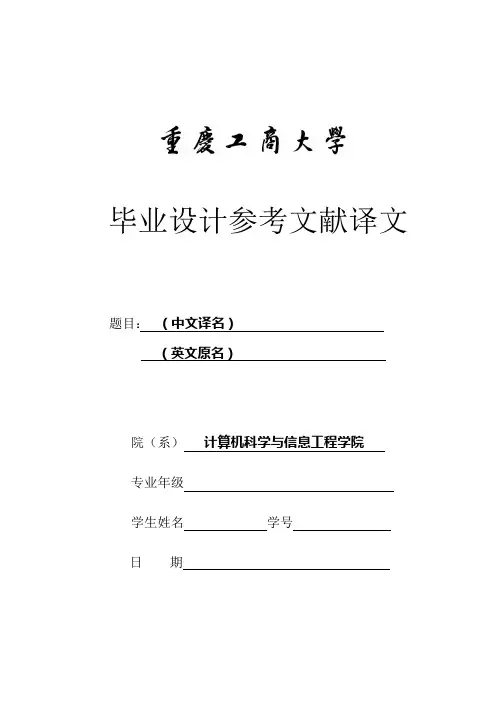
毕业设计参考文献译文
题目:(中文译名)
(英文原名)
院(系)计算机科学与信息工程学院
专业年级
学生姓名学号
日期
(中文题目,宋体三号)
摘要:(宋体五号、标准字间距、行间距为1.5倍、所有标点符号采用宋体全角、英文字母和阿拉伯数字采用半角的要求排版, 原文无摘要可不要)
………
………
(正文:不少于4000字,宋体小四、标准字间距、行间距为1.5倍、所有标点符号采用宋体全角、英文字母和阿拉伯数字采用半角的要求排版)
一、………
1.……
2.……
………
………
………
二、………
1.………
…………
…………
附录:外文参考文献
(英文题目,宋体三号)
作者名期刊名或出版社名年份及第几期
…………(排版要求同上)
……………
1。
毕业设计(论文)外文文献原文及译文Chapter 11. Cipher Techniques11.1 ProblemsThe use of a cipher without consideration of the environment in which it is to be used may not provide the security that the user expects. Three examples will make this point clear.11.1.1 Precomputing the Possible MessagesSimmons discusses the use of a "forward search" to decipher messages enciphered for confidentiality using a public key cryptosystem [923]. His approach is to focus on the entropy (uncertainty) in the message. To use an example from Section 10.1(page 246), Cathy knows that Alice will send one of two messages—BUY or SELL—to Bob. The uncertainty is which one Alice will send. So Cathy enciphers both messages with Bob's public key. When Alice sends the message, Bob intercepts it and compares the ciphertext with the two he computed. From this, he knows which message Alice sent.Simmons' point is that if the plaintext corresponding to intercepted ciphertext is drawn from a (relatively) small set of possible plaintexts, the cryptanalyst can encipher the set of possible plaintexts and simply search that set for the intercepted ciphertext. Simmons demonstrates that the size of the set of possible plaintexts may not be obvious. As an example, he uses digitized sound. The initial calculations suggest that the number of possible plaintexts for each block is 232. Using forward search on such a set is clearly impractical, but after some analysis of the redundancy in human speech, Simmons reduces the number of potential plaintexts to about 100,000. This number is small enough so that forward searches become a threat.This attack is similar to attacks to derive the cryptographic key of symmetric ciphers based on chosen plaintext (see, for example, Hellman's time-memory tradeoff attack [465]). However, Simmons' attack is for public key cryptosystems and does not reveal the private key. It only reveals the plaintext message.11.1.2 Misordered BlocksDenning [269] points out that in certain cases, parts of a ciphertext message can be deleted, replayed, or reordered.11.1.3 Statistical RegularitiesThe independence of parts of ciphertext can give information relating to the structure of the enciphered message, even if the message itself is unintelligible. The regularity arises because each part is enciphered separately, so the same plaintext always produces the same ciphertext. This type of encipherment is called code book mode, because each part is effectively looked up in a list of plaintext-ciphertext pairs.11.1.4 SummaryDespite the use of sophisticated cryptosystems and random keys, cipher systems may provide inadequate security if not used carefully. The protocols directing how these cipher systems are used, and the ancillary information that the protocols add to messages and sessions, overcome these problems. This emphasizes that ciphers and codes are not enough. The methods, or protocols, for their use also affect the security of systems.11.2 Stream and Block CiphersSome ciphers divide a message into a sequence of parts, or blocks, and encipher each block with the same key.Definition 11–1. Let E be an encipherment algorithm, and let Ek(b) bethe encipherment of message b with key k. Let a message m = b1b2…, whereeach biis of a fixed length. Then a block cipher is a cipher for whichE k (m) = Ek(b1)Ek(b2) ….Other ciphers use a nonrepeating stream of key elements to encipher characters of a message.Definition 11–2. Let E be an encipherment algorithm, and let Ek(b) bethe encipherment of message b with key k. Let a message m = b1b2…, whereeach bi is of a fixed length, and let k = k1k2…. Then a stream cipheris a cipher for which Ek (m) = Ek1(b1)Ek2(b2) ….If the key stream k of a stream cipher repeats itself, it is a periodic cipher.11.2.1 Stream CiphersThe one-time pad is a cipher that can be proven secure (see Section 9.2.2.2, "One-Time Pad"). Bit-oriented ciphers implement the one-time pad by exclusive-oring each bit of the key with one bit of the message. For example, if the message is 00101 and the key is 10010, the ciphertext is01||00||10||01||10 or 10111. But how can one generate a random, infinitely long key?11.2.1.1 Synchronous Stream CiphersTo simulate a random, infinitely long key, synchronous stream ciphers generate bits from a source other than the message itself. The simplest such cipher extracts bits from a register to use as the key. The contents of the register change on the basis of the current contents of the register.Definition 11–3. An n-stage linear feedback shift register (LFSR)consists of an n-bit register r = r0…rn–1and an n-bit tap sequence t =t 0…tn–1. To obtain a key bit, ris used, the register is shifted one bitto the right, and the new bit r0t0⊕…⊕r n–1t n–1 is inserted.The LFSR method is an attempt to simulate a one-time pad by generating a long key sequence from a little information. As with any such attempt, if the key is shorter than the message, breaking part of the ciphertext gives the cryptanalyst information about other parts of the ciphertext. For an LFSR, a known plaintext attack can reveal parts of the key sequence. If the known plaintext is of length 2n, the tap sequence for an n-stage LFSR can be determined completely.Nonlinear feedback shift registers do not use tap sequences; instead, the new bit is any function of the current register bits.Definition 11–4. An n-stage nonlinear feedback shift register (NLFSR)consists of an n-bit register r = r0…rn–1. Whenever a key bit is required,ris used, the register is shifted one bit to the right, and the new bitis set to f(r0…rn–1), where f is any function of n inputs.NLFSRs are not common because there is no body of theory about how to build NLFSRs with long periods. By contrast, it is known how to design n-stage LFSRs with a period of 2n– 1, and that period is maximal.A second technique for eliminating linearity is called output feedback mode. Let E be an encipherment function. Define k as a cryptographic key,(r) and define r as a register. To obtain a bit for the key, compute Ekand put that value into the register. The rightmost bit of the result is exclusive-or'ed with one bit of the message. The process is repeated until the message is enciphered. The key k and the initial value in r are the keys for this method. This method differs from the NLFSR in that the register is never shifted. It is repeatedly enciphered.A variant of output feedback mode is called the counter method. Instead of using a register r, simply use a counter that is incremented for every encipherment. The initial value of the counter replaces r as part of the key. This method enables one to generate the ith bit of the key without generating the bits 0…i – 1. If the initial counter value is i, set. In output feedback mode, one must generate all the register to i + ithe preceding key bits.11.2.1.2 Self-Synchronous Stream CiphersSelf-synchronous ciphers obtain the key from the message itself. The simplest self-synchronous cipher is called an autokey cipher and uses the message itself for the key.The problem with this cipher is the selection of the key. Unlike a one-time pad, any statistical regularities in the plaintext show up in the key. For example, the last two letters of the ciphertext associated with the plaintext word THE are always AL, because H is enciphered with the key letter T and E is enciphered with the key letter H. Furthermore, if theanalyst can guess any letter of the plaintext, she can determine all successive plaintext letters.An alternative is to use the ciphertext as the key stream. A good cipher will produce pseudorandom ciphertext, which approximates a randomone-time pad better than a message with nonrandom characteristics (such as a meaningful English sentence).This type of autokey cipher is weak, because plaintext can be deduced from the ciphertext. For example, consider the first two characters of the ciphertext, QX. The X is the ciphertext resulting from enciphering some letter with the key Q. Deciphering, the unknown letter is H. Continuing in this fashion, the analyst can reconstruct all of the plaintext except for the first letter.A variant of the autokey method, cipher feedback mode, uses a shift register. Let E be an encipherment function. Define k as a cryptographic(r). The key and r as a register. To obtain a bit for the key, compute Ek rightmost bit of the result is exclusive-or'ed with one bit of the message, and the other bits of the result are discarded. The resulting ciphertext is fed back into the leftmost bit of the register, which is right shifted one bit. (See Figure 11-1.)Figure 11-1. Diagram of cipher feedback mode. The register r is enciphered with key k and algorithm E. The rightmost bit of the result is exclusive-or'ed with one bit of the plaintext m i to produce the ciphertext bit c i. The register r is right shifted one bit, and c i is fed back into the leftmost bit of r.Cipher feedback mode has a self-healing property. If a bit is corrupted in transmission of the ciphertext, the next n bits will be deciphered incorrectly. But after n uncorrupted bits have been received, the shift register will be reinitialized to the value used for encipherment and the ciphertext will decipher properly from that point on.As in the counter method, one can decipher parts of messages enciphered in cipher feedback mode without deciphering the entire message. Let the shift register contain n bits. The analyst obtains the previous n bits of ciphertext. This is the value in the shift register before the bit under consideration was enciphered. The decipherment can then continue from that bit on.11.2.2 Block CiphersBlock ciphers encipher and decipher multiple bits at once, rather than one bit at a time. For this reason, software implementations of block ciphers run faster than software implementations of stream ciphers. Errors in transmitting one block generally do not affect other blocks, but as each block is enciphered independently, using the same key, identical plaintext blocks produce identical ciphertext blocks. This allows the analyst to search for data by determining what the encipherment of a specific plaintext block is. For example, if the word INCOME is enciphered as one block, all occurrences of the word produce the same ciphertext.To prevent this type of attack, some information related to the block's position is inserted into the plaintext block before it is enciphered. The information can be bits from the preceding ciphertext block [343] or a sequence number [561]. The disadvantage is that the effective block size is reduced, because fewer message bits are present in a block.Cipher block chaining does not require the extra information to occupy bit spaces, so every bit in the block is part of the message. Before a plaintext block is enciphered, that block is exclusive-or'ed with the preceding ciphertext block. In addition to the key, this technique requires an initialization vector with which to exclusive-or the initial plaintext block. Taking Ekto be the encipherment algorithm with key k, and I to be the initialization vector, the cipher block chaining technique isc 0 = Ek(m⊕I)c i = Ek(mi⊕ci–1) for i > 011.2.2.1 Multiple EncryptionOther approaches involve multiple encryption. Using two keys k and k' toencipher a message as c = Ek' (Ek(m)) looks attractive because it has aneffective key length of 2n, whereas the keys to E are of length n. However, Merkle and Hellman [700] have shown that this encryption technique can be broken using 2n+1encryptions, rather than the expected 22n(see Exercise 3).Using three encipherments improves the strength of the cipher. There are several ways to do this. Tuchman [1006] suggested using two keys k and k':c = Ek (Dk'(Ek(m)))This mode, called Encrypt-Decrypt-Encrypt (EDE) mode, collapses to a single encipherment when k = k'. The DES in EDE mode is widely used in the financial community and is a standard (ANSI X9.17 and ISO 8732). It is not vulnerable to the attack outlined earlier. However, it is vulnerable to a chosen plaintext and a known plaintext attack. If b is the block size in bits, and n is the key length, the chosen plaintext attacktakes O(2n) time, O(2n) space, and requires 2n chosen plaintexts. The known plaintext attack requires p known plaintexts, and takes O(2n+b/p) time and O(p) memory.A second version of triple encipherment is the triple encryption mode [700]. In this mode, three keys are used in a chain of encipherments.c = Ek (Ek'(Ek''(m)))The best attack against this scheme is similar to the attack on double encipherment, but requires O(22n) time and O(2n) memory. If the key length is 56 bits, this attack is computationally infeasible.11.3 Networks and CryptographyBefore we discuss Internet protocols, a review of the relevant properties of networks is in order. The ISO/OSI model [990] provides an abstract representation of networks suitable for our purposes. Recall that the ISO/OSI model is composed of a series of layers (see Figure 11-2). Each host, conceptually, has a principal at each layer that communicates with a peer on other hosts. These principals communicate with principals at the same layer on other hosts. Layer 1, 2, and 3 principals interact only with similar principals at neighboring (directly connected) hosts. Principals at layers 4, 5, 6, and 7 interact only with similar principals at the other end of the communication. (For convenience, "host" refers to the appropriate principal in the following discussion.)Figure 11-2. The ISO/OSI model. The dashed arrows indicate peer-to-peer communication. For example, the transport layers are communicating with each other. The solid arrows indicate the actual flow of bits. For example, the transport layer invokes network layer routines on the local host, which invoke data link layer routines, which put the bits onto the network. The physical layer passes the bits to the next "hop," or host, on the path. When the message reaches the destination, it is passed up to the appropriatelevel.Each host in the network is connected to some set of other hosts. They exchange messages with those hosts. If host nob wants to send a message to host windsor, nob determines which of its immediate neighbors is closest to windsor (using an appropriate routing protocol) and forwards the message to it. That host, baton, determines which of its neighbors is closest to windsor and forwards the message to it. This process continues until a host, sunapee, receives the message and determines that windsor is an immediate neighbor. The message is forwarded to windsor, its endpoint.Definition 11–5. Let hosts C0, …, Cnbe such that Ciand Ci+1are directlyconnected, for 0 i < n. A communications protocol that has C0 and Cnasits endpoints is called an end-to-end protocol. A communications protocolthat has Cj and Cj+1as its endpoints is called a link protocol.The difference between an end-to-end protocol and a link protocol is that the intermediate hosts play no part in an end-to-end protocol other than forwarding messages. On the other hand, a link protocol describes how each pair of intermediate hosts processes each message.The protocols involved can be cryptographic protocols. If the cryptographic processing is done only at the source and at the destination, the protocol is an end-to-end protocol. If cryptographic processing occurs at each host along the path from source to destination, the protocolis a link protocol. When encryption is used with either protocol, we use the terms end-to-end encryption and link encryption, respectively.In link encryption, each host shares a cryptographic key with its neighbor. (If public key cryptography is used, each host has its neighbor's public key. Link encryption based on public keys is rare.) The keys may be set on a per-host basis or a per-host-pair basis. Consider a network with four hosts called windsor, stripe, facer, and seaview. Each host is directly connected to the other three. With keys distributed on a per-host basis, each host has its own key, making four keys in all. Each host has the keys for the other three neighbors, as well as its own. All hosts use the same key to communicate with windsor. With keys distributed on a per-host-pair basis, each host has one key per possible connection, making six keys in all. Unlike the per-host situation, in the per-host-pair case, each host uses a different key to communicate with windsor. The message is deciphered at each intermediate host, reenciphered for the next hop, and forwarded. Attackers monitoring the network medium will not be able to read the messages, but attackers at the intermediate hosts will be able to do so.In end-to-end encryption, each host shares a cryptographic key with each destination. (Again, if the encryption is based on public key cryptography, each host has—or can obtain—the public key of each destination.) As with link encryption, the keys may be selected on a per-host or per-host-pair basis. The sending host enciphers the message and forwards it to the first intermediate host. The intermediate host forwards it to the next host, and the process continues until the message reaches its destination. The destination host then deciphers it. The message is enciphered throughout its journey. Neither attackers monitoring the network nor attackers on the intermediate hosts can read the message. However, attackers can read the routing information used to forward the message.These differences affect a form of cryptanalysis known as traffic analysis.A cryptanalyst can sometimes deduce information not from the content ofthe message but from the sender and recipient. For example, during the Allied invasion of Normandy in World War II, the Germans deduced which vessels were the command ships by observing which ships were sending and receiving the most signals. The content of the signals was not relevant; their source and destination were. Similar deductions can reveal information in the electronic world.第十一章密码技术11.1问题在没有考虑加密所要运行的环境时,加密的使用可能不能提供用户所期待的安全。
【关键字】方式本科毕业论文(设计)外文翻译学院:专业:班级:学号:学生姓名:指导教师:二○ 年月外文翻译之一外文原文题目(三号,Arial)作者:(外文,小四,times new roman)原文作者姓名标注方式全部姓名出处:(外文,小四,times new roman)期刊名,年份,卷(期):页码,如书等其他文献参照正文参照文献标注方式外文翻译之二外文原文题目(三号,Arial)作者:(外文,小四,times new roman)原文作者姓名标注方式全部姓名出处:(外文,小四,times new roman)期刊名,年份,卷(期):页码,如书等其他文献参照正文参照文献标注方式外文原文(可附pdf原件),装订次序为原文1,译文1,原文2,译文2.两篇译文可单独编页码顺序.译文1中文译文题目(三号,黑体/Arial)作者:(五号,times new roman,外文)出处:(五号,times new roman,外文)摘要(加粗):(中文宋体英文times new roman五号,行距1.5倍)关键词(加粗):(中文宋体英文times new roman五号,行距1.5倍,关键词之间使用分号间隔)译文正文中文宋体英文times new roman,小四,行距1.5倍;标题小四加粗顶格正文小四;表图题五号字体加粗单倍行距。
表图文及注五号字体不加粗单倍行距。
其余未说明的格式要求可按照指导教师要求为准。
译文2中文译文题目(三号,黑体)作者:(五号,英文times new roman)出处:(五号,英文times new roman)摘要(加粗):(中文宋体英文times new roman五号,行距1.5倍)关键词(加粗):(中文宋体英文times new roman五号,行距1.5倍,关键词之间使用分号间隔)译文正文中文宋体英文times new roman,小四,行距1.5倍;标题小四加粗顶格正文小四;表图题五号字体加粗单倍行距。